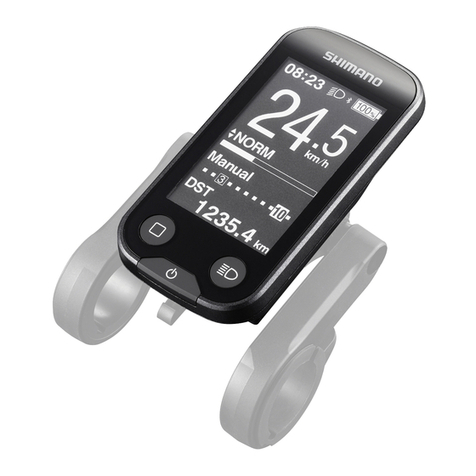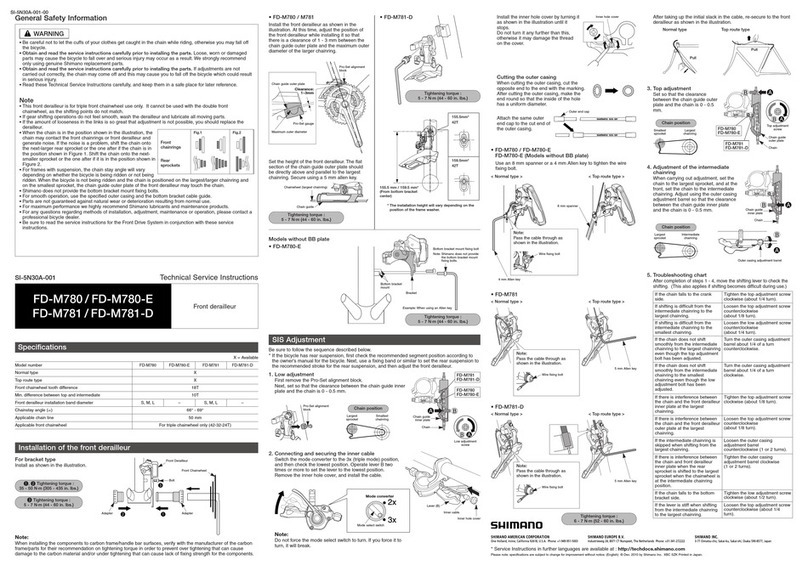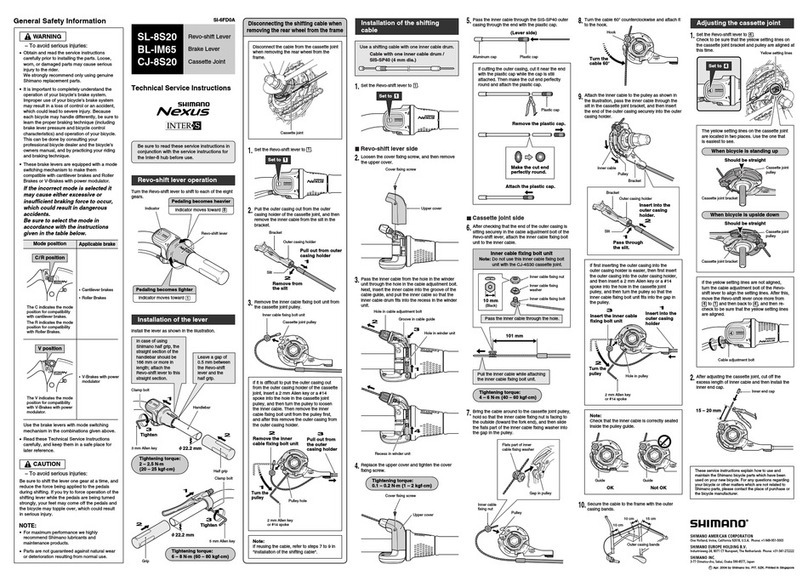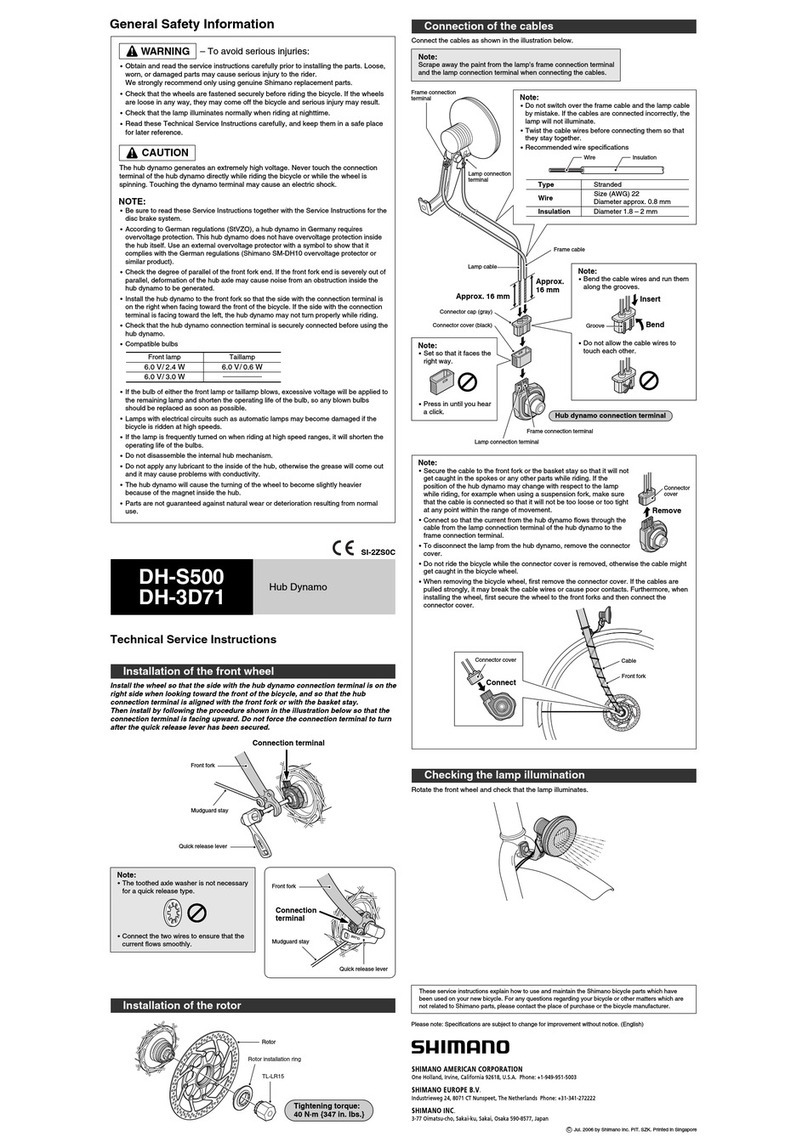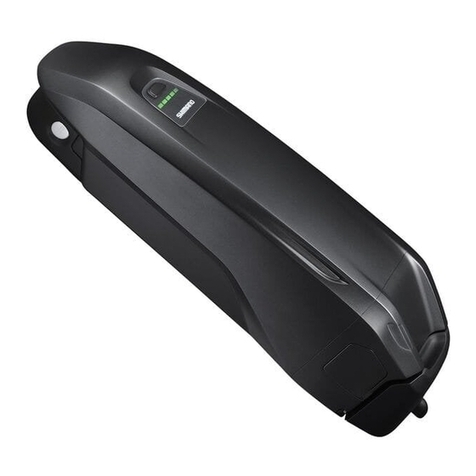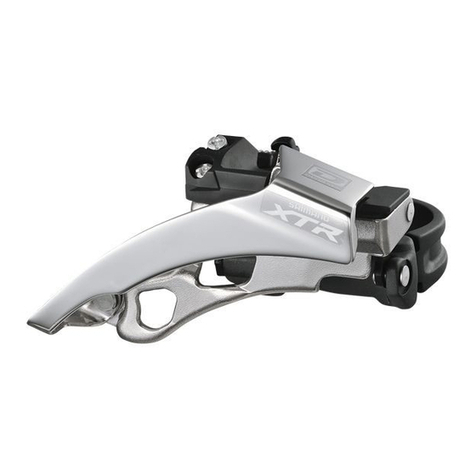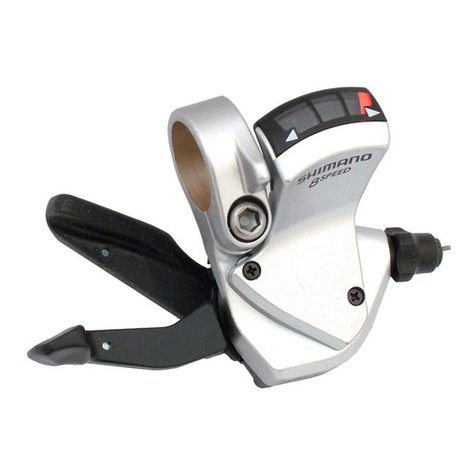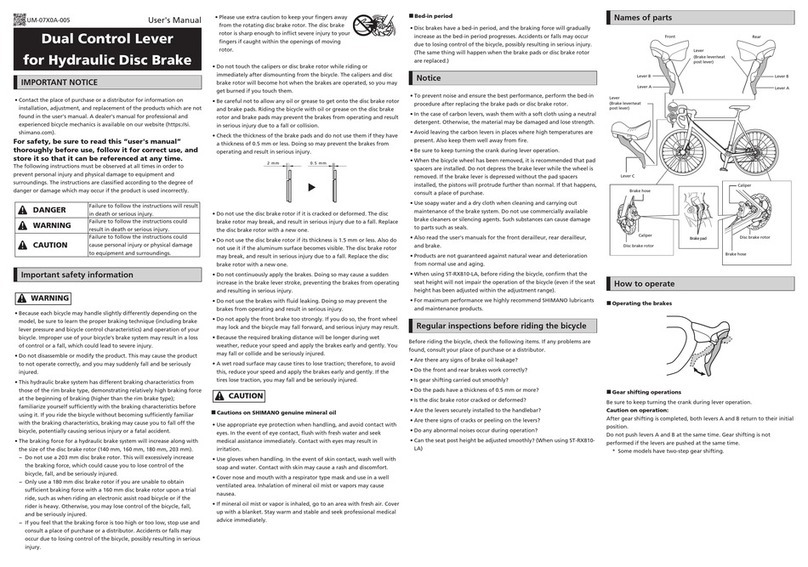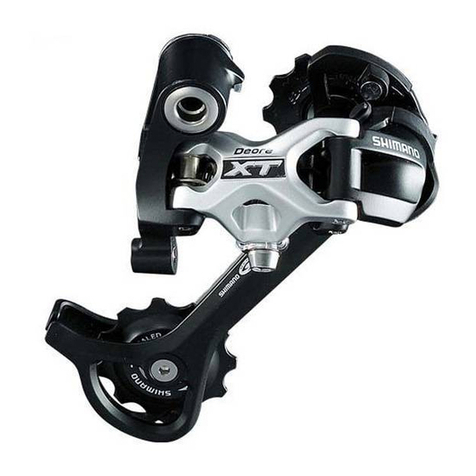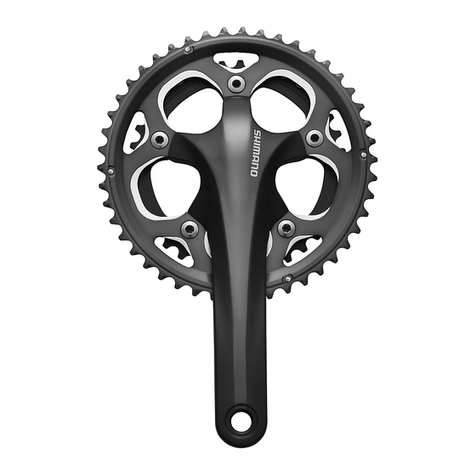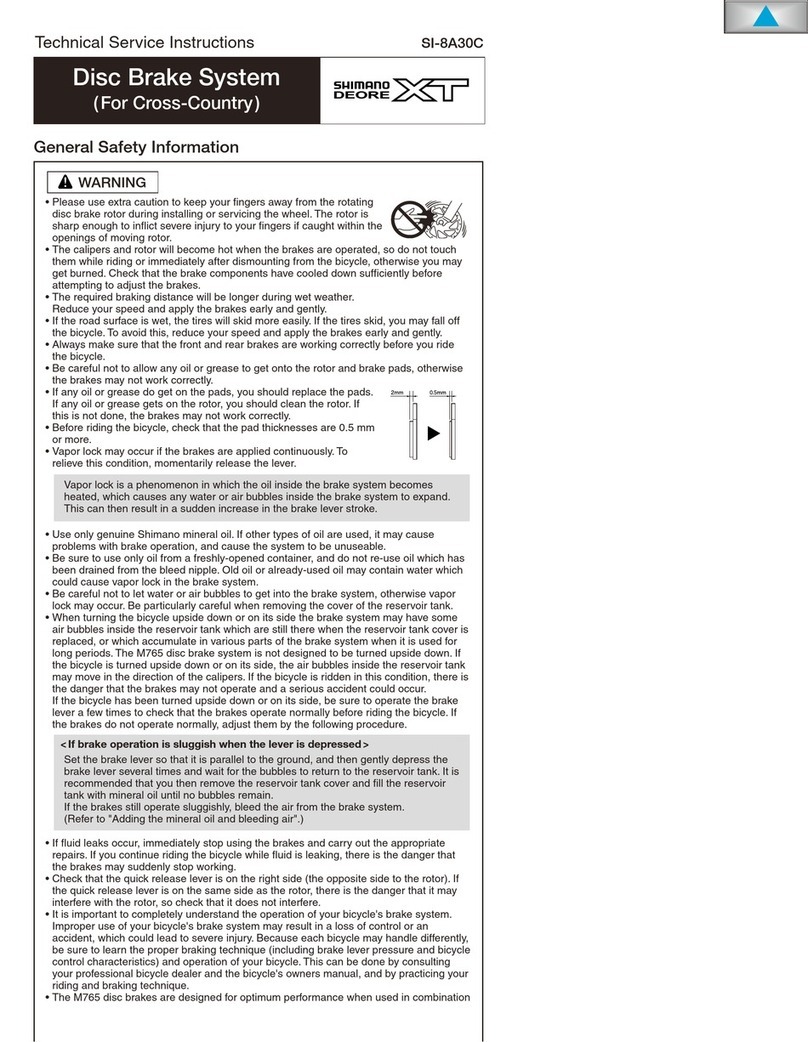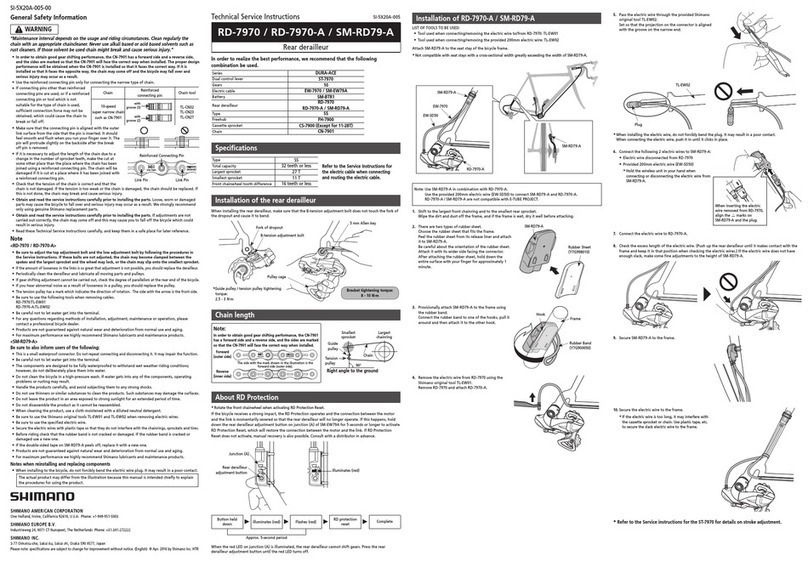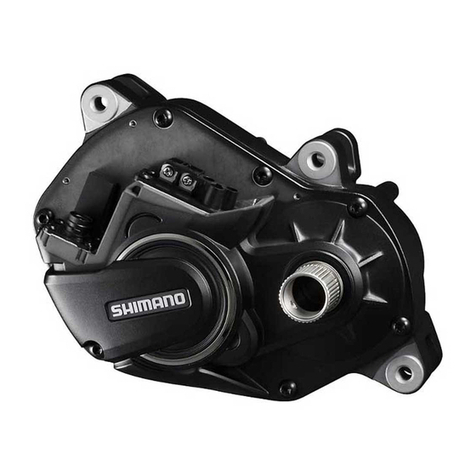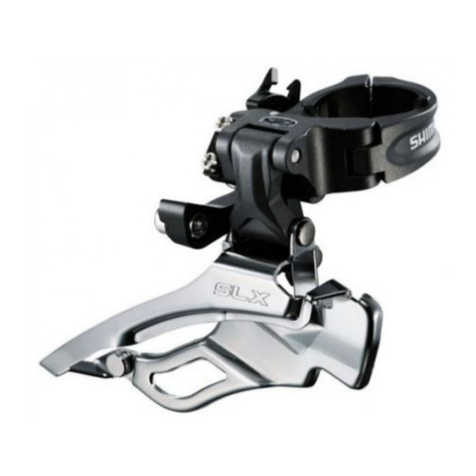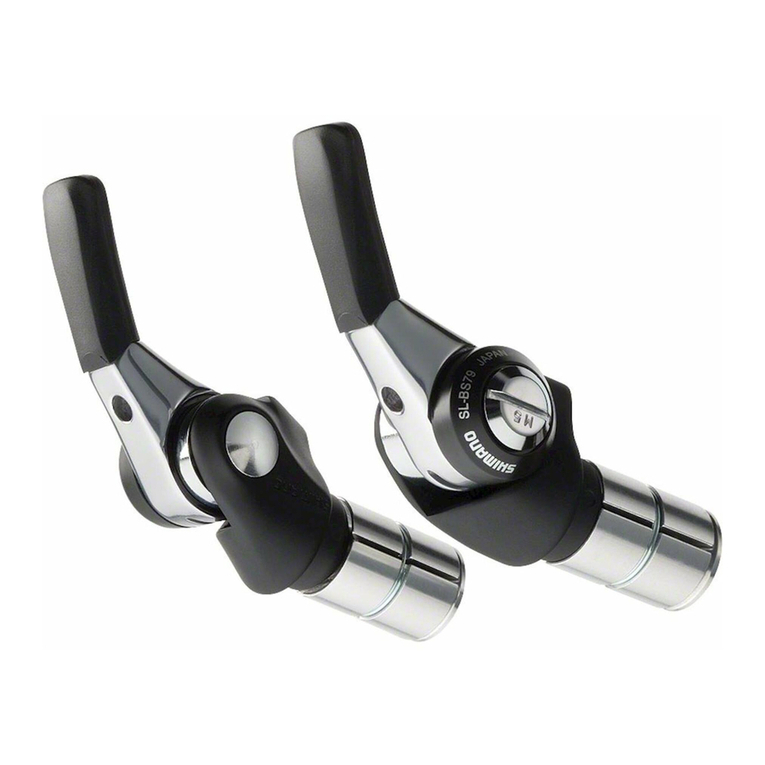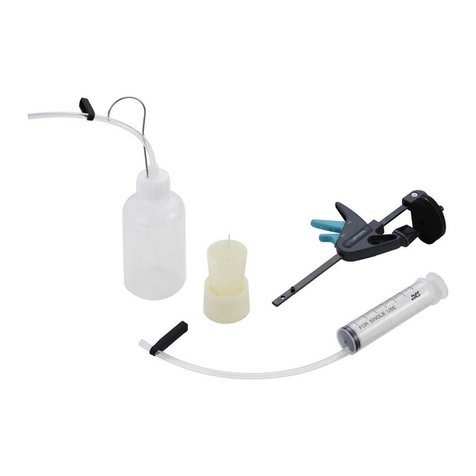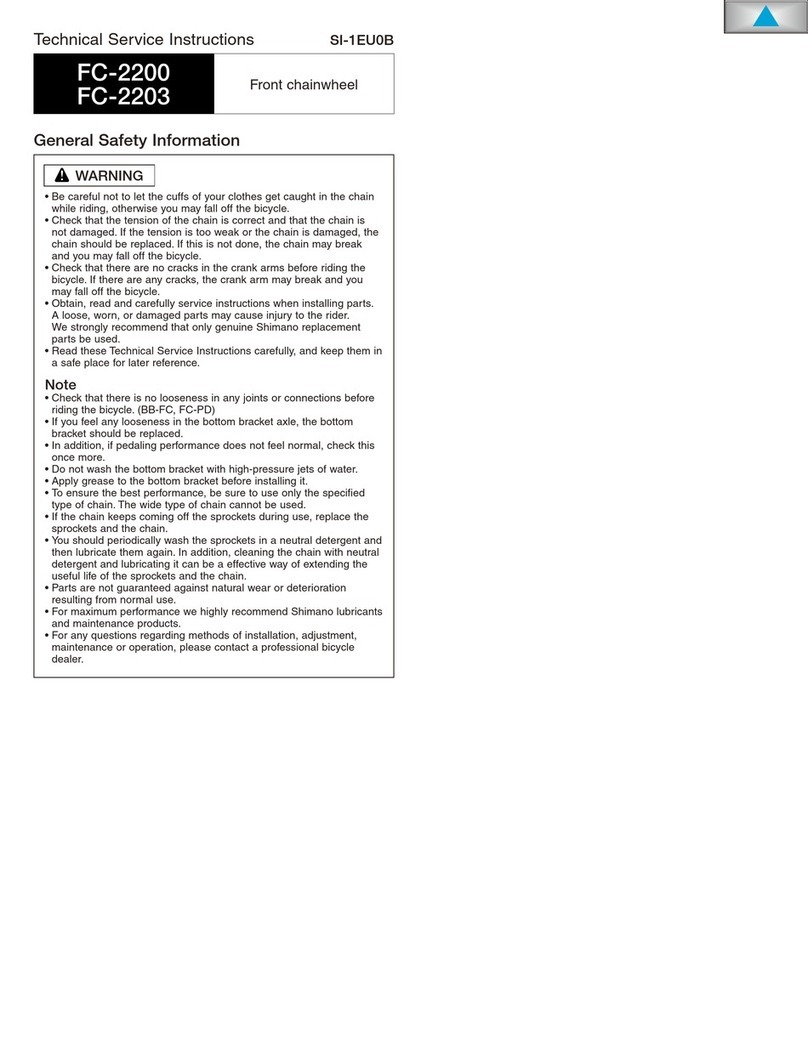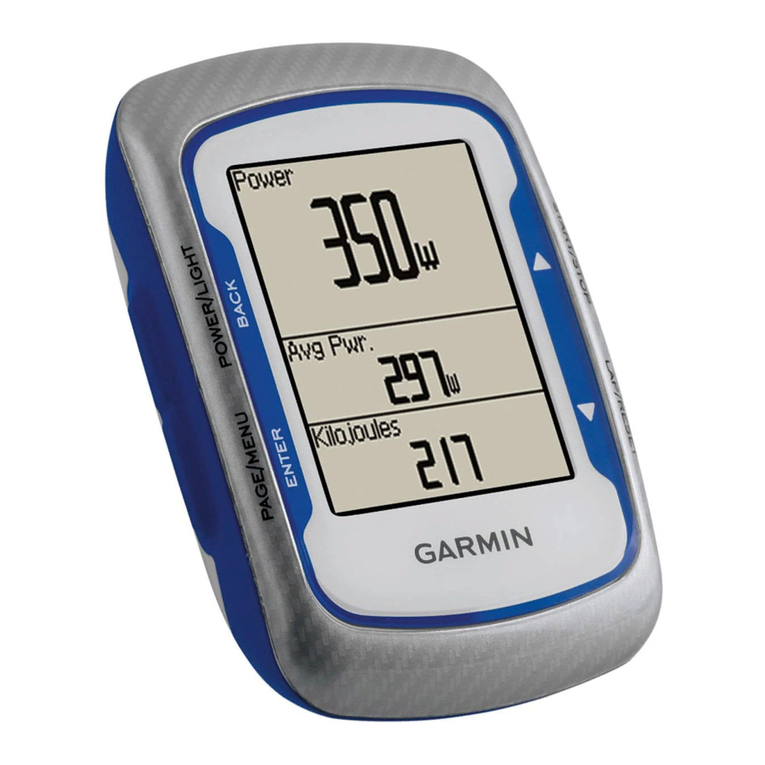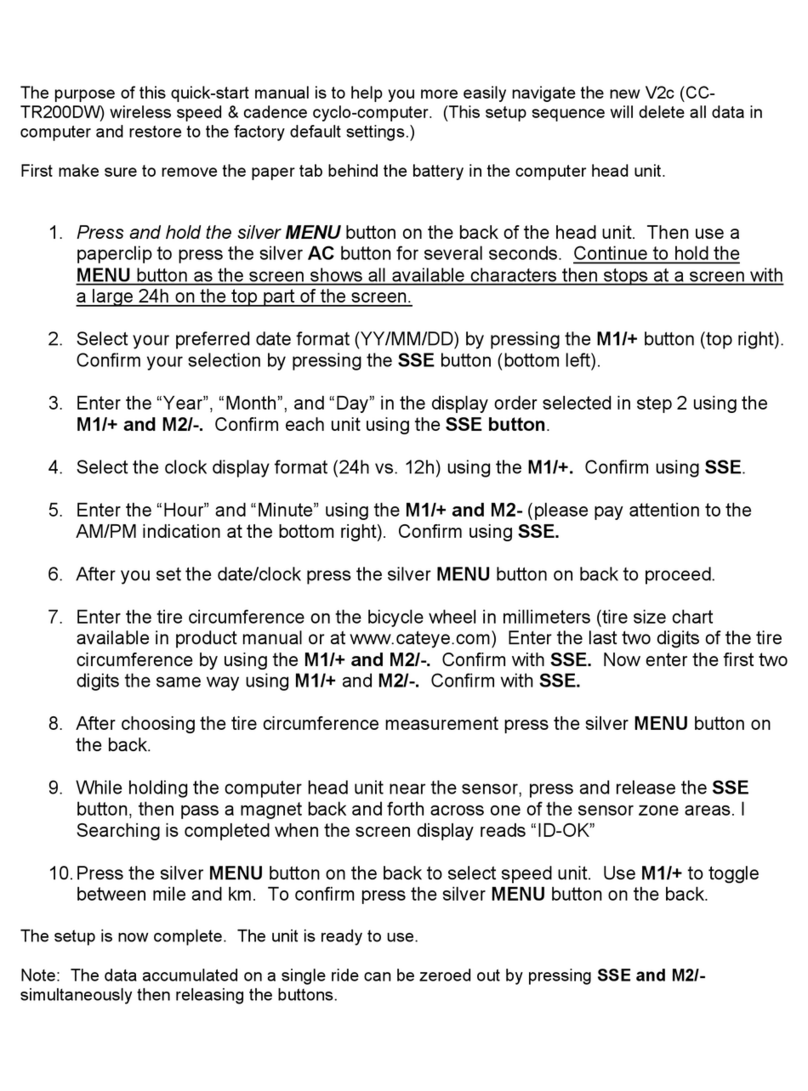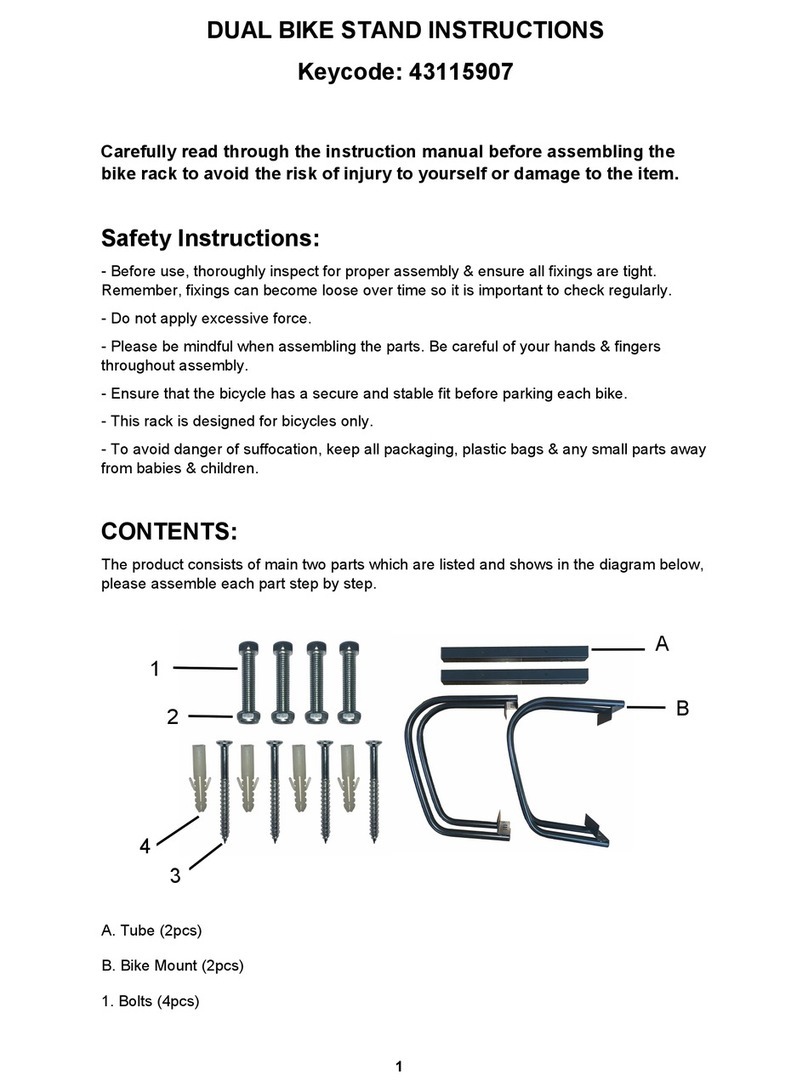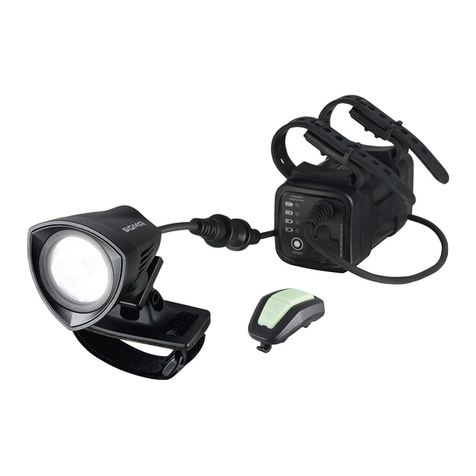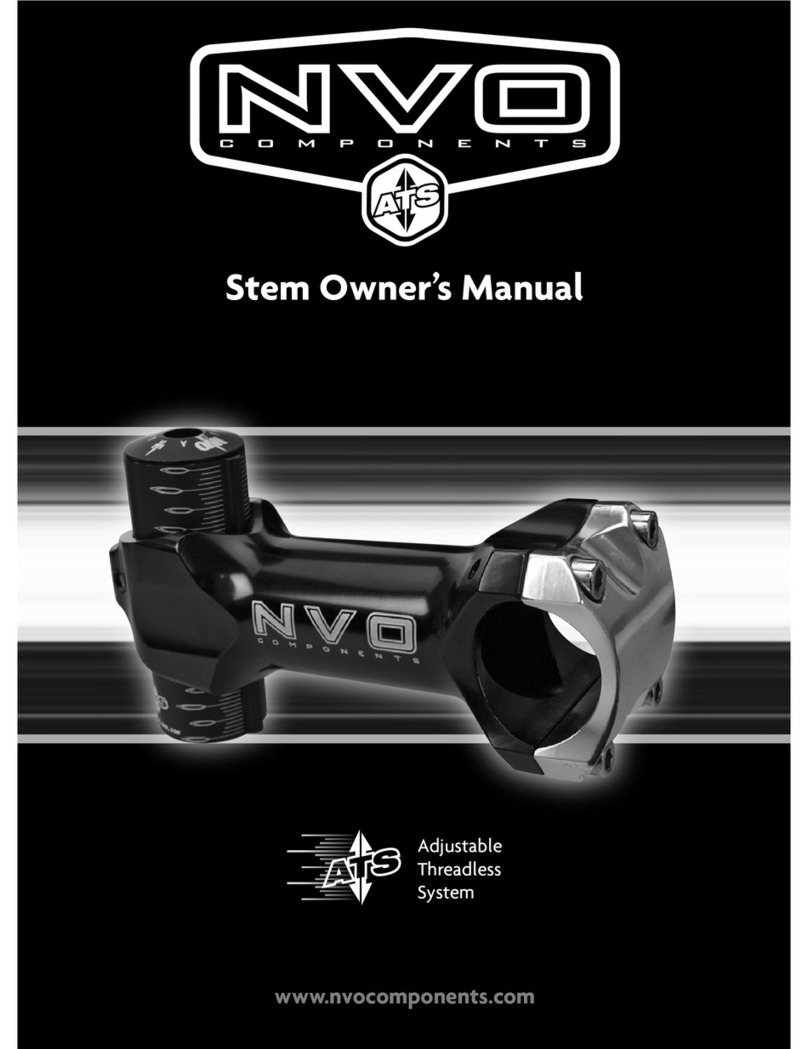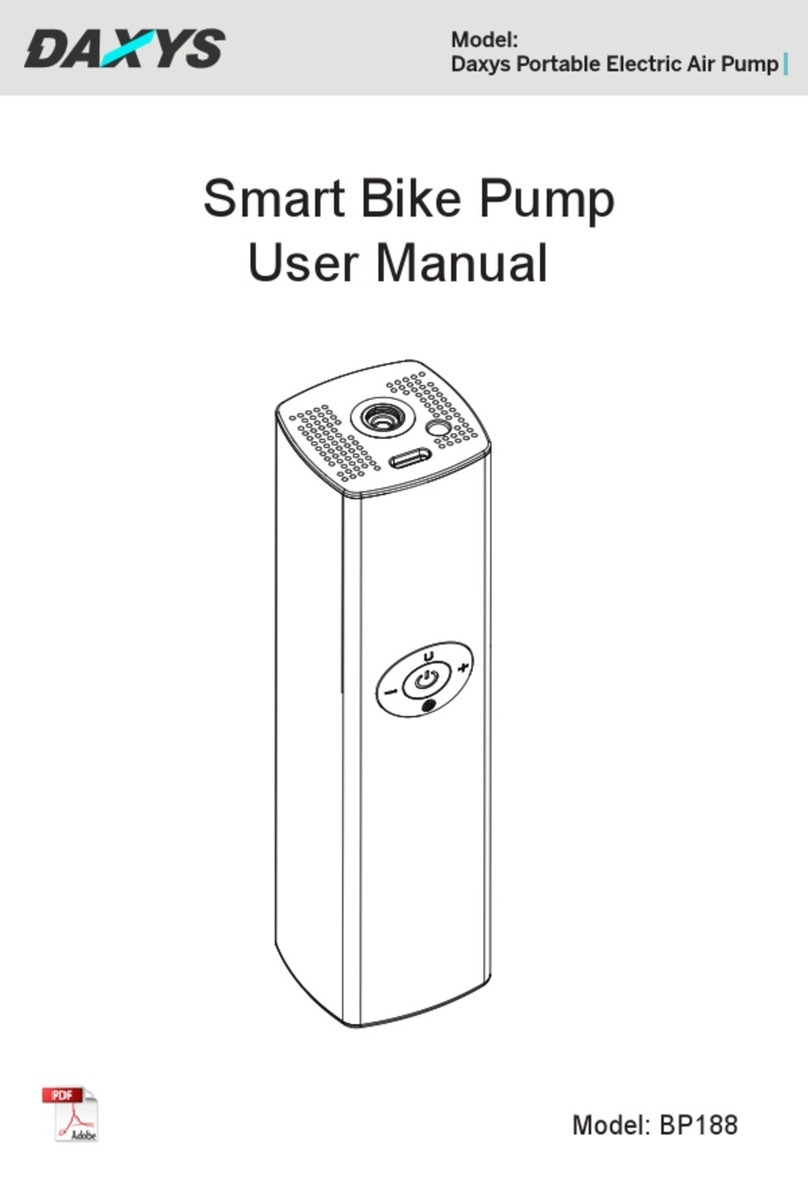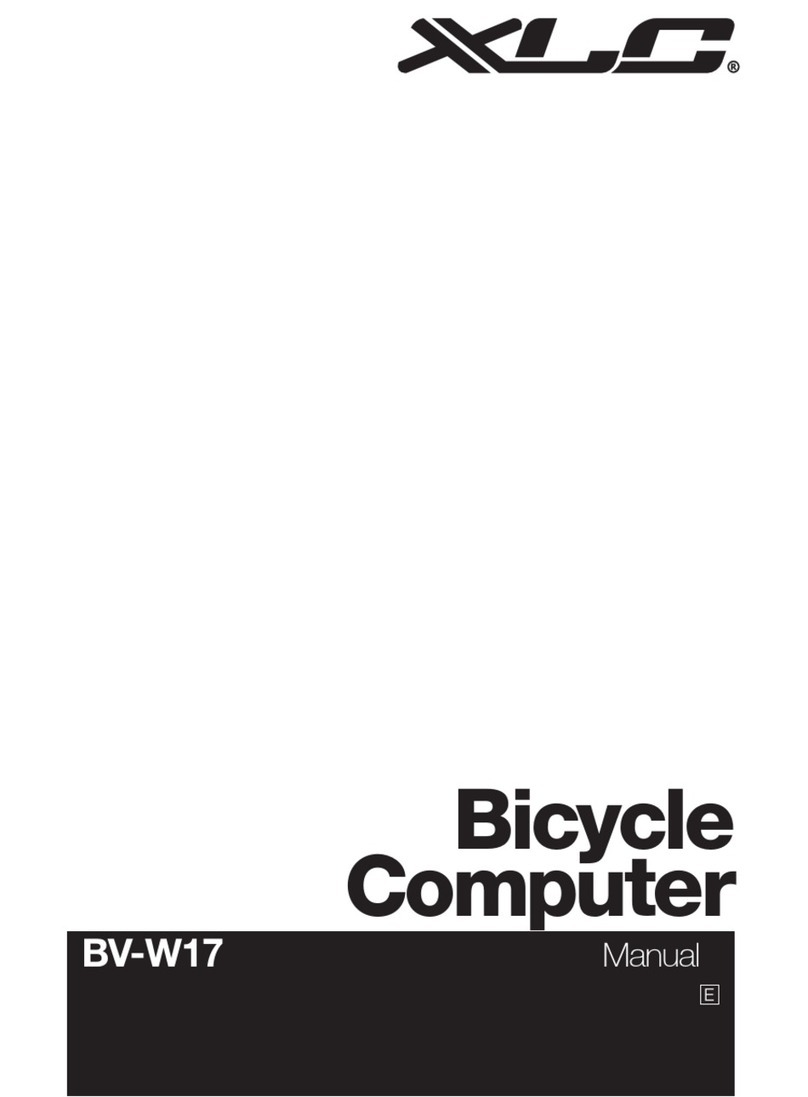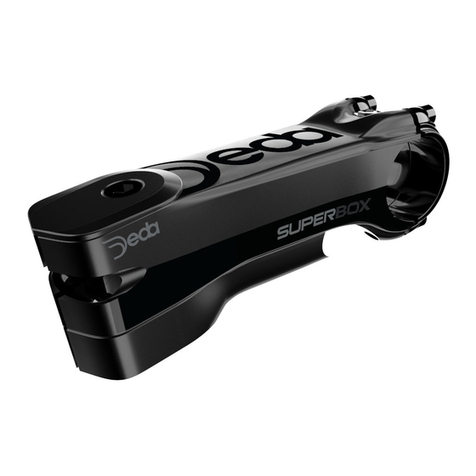■Installation of the calipers (BR-M985) and securing the hose.
•Removethespacerforbleeding(yellow),andthensetthewheelwhichhastherotorontothe
frame.
•Installthebrakepads.
■Installation of the rotor
(SM-RT98)
SM-RT98L (203mm)
SM-RT98M (180mm)
SM-RT98S (160mm)
SM-RT98SS (140mm)
* The RT98SS (140 mm) rotor is
for rear use only.
The following tools are needed to assemble this product.
Usage location
Rotor fixing lock ring
Brake lever fixing bolt
Caliper fixing bolt
Brake pad fixing shaft
Brake lever bleed screw
Cable supporter
Brake hose fixing bolt
Bleed nipple
Bleeding
TL-LR15
Allen key 4 mm
Allen key 4 mm
Adapter (post type) fixing bolt Allen key 4 mm
Flat-tipped screwdriver
Allen key 2.5 mm
Phillips screwdriver #2
8 mm wrench / Allen key 3 mm, 4 mm
7 mm socket wrench
Caliper bleed screw (option)
Bleeding adapter (option)
Allen key 3 mm
TL-BR25
SM-DISC, Syringe
Tool
Tightening torque:
40 - 50 N·m {350 - 435 in. lbs.}
Te c h n i c a l S e r v i c e I n s t r u c t i o n s SI-8J70A-005
Disc Brake System
Caliper
Brake Lever
Rotor
Hose
Cable Supporter
BR-M985
BL-M985 / BL-M988
SM-RT98
SM-BH90-SB
SM-HANG
Mineral Oil
Brake pad unit Without fins With fins
Resin Pads
Metal Pads
SM-DB-OIL
G01A
G03Ti
F01A
F03C
In order to realize the best performance, we recommend that the following
combination be used.
■Installation of the hose
■Installation of the brake lever (BL-M985/M988)
Secure the brake lever as shown in the illustration. (Check
that the brake lever does not interfere with the shifting lever
during operation. Refer to the Service Instructions for the
shifting lever also. Some types might require the shifting
lever to be installed first, due to the position of the shifting
lever fixing bolts.)
When installing the components to carbon frame/handle bar
surfaces, verify with the manufacturer of the carbon
frame/parts for their recommendation on tightening torque in
order to prevent over tightening that can cause damage to
the carbon material and/or under tightening that can cause
lack of fixing strength for the components.
Brake lever Tightening torque:
6 - 8 N·m {53 - 69 in. lbs.}
If bolt 1tries to loosen (turn in the counterclockwise direction), force is
applied via the wire to turn bolt 2in the tightening direction (clockwise).
However, bolt 2cannot turn any further in the tightening direction.
Accordingly, this prevents bolt 1from turning in the loosening direction
because it is also connected via the wire.
If either one of the bolts tries to loosen, this causes a force to be applied
to the other bolt to turn it in the tightening direction. In other words, this
system prevents the bolts from loosening.
Wind a wire around the fixing
bolt between the adapter and
the frame as shown in the
illustration.
Brake pads
Bolt 1
Bolt 2
Spacer for bleeding
Wire
Bolt
Tightening torque:
0.2 - 0.4 N·m {1.8 - 3.5 in. lbs.}
Secure the two bolts with a length of wire as shown
in the illustration in order to prevent the bolts from
coming loose.
Rotor fixing
lock ring
TL-LR15
For C-shaped guides and the usual
type of cable stoppers, use the
special Shimano cable supporter
(sold separately) to secure as
shown in the illustration.
Operate the brake lever several times and check whether the brakes operate normally or
not. Also check that there are no oil leaks visible.
Tightening torque:
0.3 - 0.5 N·m {2.7 - 4.4 in. lbs.}
< C-shaped guide > < Usual type of cable stopper >
■Brake pad replacement
Maintenance
Note: The M985 brake system is designed so that as the brake pads become worn,
the pistons gradually move outward to automatically adjust the clearance between
the rotor and the brake pads. Therefore, you need to push the pistons back to
their original positions when replacing the brake pads.
If oil adheres to the brake pads after oil is added, or if
the brake pads are worn down to a thickness of 0.5 mm,
or if the brake pad presser springs are interfering with
the rotor, replace the brake pads.
1. Remove the wheel from the frame, and remove the
brake pads as shown in the illustration.
2. Clean the pistons and surrounding area.
3. Use a flat-shaped tool to push the pistons straight
back in as far as they will go, while being careful not
to twist the pistons. Do not push the pistons with a
sharp tool. The pistons may become damaged.
4. Install the new brake pads, and then install
the pad spacers (red). Make sure that you
do not forget to install the snap rings at
this time also.
5. Depress the brake lever several times to check that the operation becomes stiff.
6. Remove the pad spacers, install the wheel, and then check that there is no interference
between the rotor and the caliper. If they are touching, adjust while referring to
"Installation of the caliper".
■Adjustment when the pistons are not operating correctly
The caliper mechanism includes two pistons. If these pistons do not operate properly or if
they protrude unevenly, or if the brake pads remain in contact with the rotor, adjust the
pistons by the following procedure.
1. Remove the wheel and the brake pads. Clean the pistons and surrounding area.
2. Use a flat-shaped tool to push the pistons straight back in as far as they will go, while
being careful not to twist the pistons. Do not push the pistons with a sharp tool. The
pistons may become damaged.
3. Install the brake pads and the pad spacers (red).
4. Depress the brake lever as far as it will go, and then operate it several more times so
that the two pistons all move to their initial positions.
5. Remove the pad spacer, install the wheel, and then check that there is no interference
between the rotor and the brake pads. If they are touching, loosen the installation bolts
and adjust so that they are no longer touching.
■Mineral oil replacement
It is recommended that you replace the oil inside the reservoir tank if it becomes
severely discolored.
Attach a tube with a bag to the bleed nipple, and then open the bleed nipple and
drain out the oil. You can operate the brake lever at this time to help the oil to
drain out. After draining the fluid, pour in fresh brake fluid while referring to
"Adding the mineral oil and bleeding air". Use only genuine Shimano mineral oil.
Dispose of the waste oil according to proper country and/or state disposal
regulations.
The bleed nipple of the BR-M985 can be replaced with the included caliper
bleed screw in order to reduce weight. If using the caliper bleed screw, it will be
necessary to use the TL-BR25 bleeding adapter and the SM-DISC (oil funnel
and oil stopper) when carrying out air bleeding operations.
■Installation of the SL-M980-I and the BL-M985/M988
1. Use a 2 mm Allen key to open the clamp band
of the brake lever as shown in the illustration.
2. Insert the hook of the shifting lever bracket
into the hole in the brake lever bracket, and
then provisionally tighten the special nut and
special bolt to install it to the handlebar.
3. Use a 4 mm Allen key to secure the
shifting lever to the brake lever.
Refer to the "Adding the mineral oil and bleeding air" and "Adding
the mineral oil and bleeding air (when using the caliper bleed
screw)" Service Instructions in conjunction with these Service
Instructions.
Pad spacer (red)
Snap ring
Refer to the Service Instructions for the SM-BH90-SB brake hose (SI-8JA0A) for details on
installing the hose.
Do not let the hose become twisted when installing. Make sure that the calipers and levers are in
the positions shown in the illustrations.
Pad with fins
The pads with fins have fins
at the front and back, so
install them as shown in the
illustration.
Set the pad presser spring as
shown in the illustration.
(There are left (L) and right (R)
marks on the spring.)
Piston
Installation
■Wheel spoke lacing
Check that the spokes have been laced as shown in the illustration.
A radial assembly cannot be used.
Lace the spokes as shown in Figure 1 below for the left side of the front wheel
(the side where the rotor is installed), and the left and right sides of the rear
wheel, and as shown in Figure 2 below for the right side of the front wheel.
< Front >
< Front >
< Rear >
Tightening torque:
6 - 8 N·m {53 - 69 in. lbs.}
Tightening torque:
6 - 8 N·m {53 - 69 in. lbs.}
Caliper
Rotor
Adapter
Caliper fixing
bolts
Caliper fixing
bolts
Adapter
fixing bolts
Adapter
fixing bolts
●International standard mounting type ●Post mounting type
Provisionally install the caliper to the
frame (so that the caliper can move
sideways), depress the brake lever
so that the rotor is being clamped by
the pads, and then tighten the caliper
fixing bolts.
For international-standard mounts, attach adapters to calipers for post-type mounts.
(Separate front and rear adapters are available.)
1. First install the adapter, and then provisionally secure the calipers to the frame. (The calipers
should be able to move sideways.)
2. Depress the brake lever so that the rotor is being clamped by the pads, and then tighten the
caliper fixing bolts.
Pad presser spring
Snap ring
For post type
Free s trok e
adjustment screw
Rotor
Pad
Contact
Pad contact point
■Free stroke adjustment
When the free stroke adjustment screw is loosened, the free stroke of the
brake lever will increase, so that you can adjust it to the desired setting.
Reach
adjustment bolt
Reach adjustment bolt
■Reach adjustment
Tighten the adjust bolt (clockwise) to
increase the stroke, and loosen it
(counterclockwise) to decrease the
stroke.
Using a 2 mm Allen key, tighten
the adjust bolt (clockwise) to
increase the stroke, and loosen it
(counterclockwise) to decrease the
stroke.
< BL-M988 >
< BL-M988 > < BL-M985 >
Tightening torque:
0.2 - 0.4 N·m {1.8 - 3.5 in. lbs.}
Note:
Do not install the nut upside-down.
If it is installed upside-down, it will not be
possible to secure the brake lever to the
handlebars, and damage may occur.
Hook
Push
Clamp band
Bolt (M5 x 12.5 mm)
Nut
1
1
2
2
Tightening torque:
3 N·m {26 in. lbs.}
4. Use a 4 mm Allen key to secure the clamp
band of the brake lever.
Tightening torque:
6 - 8 N·m {53 - 69 in. lbs.}
General Safety Information
WARNING
•The203mmand180mmrotorsprovideahigherbrakingforcethanthe160mmrotors.Make
sure that you have a complete feel for the braking characteristics before using the brakes.
•Pleaseuseextracautiontokeepyourfingersawayfromtherotatingdisc
brake rotor during installing or servicing the wheel. The rotor is sharp enough
to inflict severe injury to your fingers if caught within the openings of moving
rotor.
•Thecalipersandrotorwillbecomehotwhenthebrakesareoperated,sodonottouchthem
while riding or immediately after dismounting from the bicycle, otherwise you may get burned.
Check that the brake components have cooled down sufficiently before attempting to adjust the
brakes.
•Therequiredbrakingdistancewillbelongerduringwetweather.
Reduce your speed and apply the brakes early and gently.
•Iftheroadsurfaceiswet,thetireswillskidmoreeasily.Ifthetiresskid,youmayfalloffthe
bicycle. To avoid this, reduce your speed and apply the brakes early and gently.
•Alwaysmakesurethatthefrontandrearbrakesareworkingcorrectlybeforeyouridethe
bicycle.
•Iftherotoriscrackedorwarped,besuretoreplaceitwithanewrotor.
•Iftherotorbecomesworndowntoathicknessof1.5mmorsothatthealuminumsurface
becomes visible, be sure to replace the rotor with a new one.
•Becarefulnottoallowanyoilorgreasetogetontotherotorandbrakepads,otherwisethe
brakes may not work correctly.
•Ifanyoilorgreasedogetonthepads,besuretoreplacethemwithnew
pads. If any oil or grease gets on the rotor, you should clean the rotor. If this
is not done, the brakes may not work correctly.
•Beforeridingthebicycle,checkthatthethicknessofeachpadis0.5mmor
more.
•Vaporlockmayoccurifthebrakesareappliedcontinuously.Torelievethis
condition, momentarily release the lever.
•UseonlygenuineShimanomineraloil.Ifothertypesofoilareused,itmaycauseproblems
with brake operation, and cause the system to be unuseable.
•Besuretouseonlyoilfromafreshly-openedcontainer,anddonotre-useoilwhichhasbeen
drained from the bleed nipple. Old oil or already-used oil may contain water which could cause
vapor lock in the brake system.
•Becarefulnottoletwaterorairbubblesgetintothebrakesystem,otherwisevaporlocksmay
occur. Be par ticularly careful when removing the bleed screws.
•Ifcuttingthebrakehoseinordertoadjustthelengthofthehose,orwhenchangingoverthe
brake hose from left to right or vice versa, be sure to bleed the air from the hose by carrying
out steps (4), (8) to (12) given in “Adding mineral oil and bleeding air” in the Service
Instructions.
•Whenturningthebicycleupsidedownoronitsside,thebrakesystemmayhavesomeair
bubbles inside the reser voir tank which are still there when the bleed screws are replaced, or
which accumulate in various parts of the brake system when it is used for long periods. The
M985 disc brake system is not designed to be turned upside down. If the bicycle is turned
upside down or on its side, the air bubbles inside the reservoir tank may move in the direction
of the calipers. If the bicycle is ridden in this condition, there is the danger that the brakes may
not operate and a serious accident could occur. If the bicycle has been turned upside down or
on its side, be sure to operate the brake lever a few times to check that the brakes operate
normally before riding the bicycle. If the brakes do not operate normally, adjust them by the
following procedure.
•Iffluidleaksoccur,immediatelystopusingthebrakesandcarryouttheappropriaterepairs.If
you continue riding the bicycle while fluid is leaking, there is the danger that the brakes may
suddenly stop working.
•Ifthequickreleaseleverisonthesamesideastherotor,thereisthedangerthatitmay
interfere with the rotor, so check that it does not interfere.
•Itisimportanttocompletelyunderstandtheoperationofyourbicycle'sbrakesystem.Improper
use of your bicycle's brake system may result in a loss of control or an accident, which could
lead to severe injury. Because each bicycle may handle differently, be sure to learn the proper
braking technique (including brake lever pressure and bicycle control characteristics) and
operation of your bicycle. This can be done by consulting your professional bicycle dealer and
the bicycle's owners manual, and by practicing your riding and braking technique.
•Ifthefrontbrakeisappliedtoostrongly,thewheelmaylockandthebicyclemayfallforward,
and serious injury may result.
•Shimanodiscbrakesystemsarenotcompatiblewithtandembicycles.Becausetandem
bicycles have a high overall weight, the load on the brake system increases during brake
operation. If hydraulic disc brakes are used with tandem bicycles, the oil temperature will
become too high and vapor locks or ruptures in the brake hoses may occur, and this will cause
the brakes to fail.
•Obtain and read the service instructions carefully prior to installing the parts. Loose, worn
or damaged parts may cause the bicycle to fall over and serious injury may occur as a result.
We strongly recommend only using genuine Shimano replacement parts.
•ReadtheseTechnicalServiceInstructionscarefully,andkeeptheminasafeplaceforlater
reference.
•G01A/F01Abrakepadsaredesignedtoreducetheamountofnoisewhichisgenerated
between the pads and the rotor when the brakes are operated. A longer running-in period is
required for this type of pad compared to G03Ti/F03C pads.
■Handling the mineral oil
•Usesafetyglasseswhenhandling,andavoidcontactwitheyes.Contactwitheyesmayresultin
irritation.
In the event of eye contact, flush with fresh water and seek medical assistance immediately.
•Usegloveswhenhandling.Contactwithskinmaycausearashanddiscomfort.
In the event of skin contact, wash well with soap and water.
•Inhalationofoilmistorvaporsmaycausenausea.Covernoseandmouthwitharespiratortype
mask and use in a well ventilated area.
If mist or vapor is inhaled, go immediately to an area with fresh air. Cover up with a blanket.
Stay warm and stable and seek professional medical advice.
•Donotdrink.Maycausevomitingordiarrhea.
CAUTION
Vap or lo ck i s a phe nom en on in w hic h the o il i nsi de th e brake s ys tem b eco mes h ea ted ,
which causes any water or air bubbles inside the brake system to expand. This can then
result in a sudden increase in the brake lever stroke.
< If brake operation is sluggish when the lever is depressed >
Gently depress the brake lever several times and wait for the bubbles to return to the
reservoir tank. It is recommended that you then remove the bleed screws and fill the
reservoir tank with mineral oil until no air bubbles remain.
If the brakes still operate sluggishly, bleed the air from the brake system. (Refer to "Adding
the mineral oil and bleeding air".)
•Keepoutofreachofchildren.
•Donotcut,heat,weldorpressurizetheoilcontainer,asthismaycause
explosion or fire.
•DisposalofUsedOil:Followlocalcountyand/orstatecodesfordisposal.Use
care when preparing oil for disposal.
•Directions:Keepthecontainersealedtopreventforeignobjectsandmoisture
from getting inside, and store it in a cool, dark area away from direct
sunlight or heat.
■Burn-in period
•Discbrakeshaveaburn-inperiod,andthebrakingforcewillgraduallyincrease
as the burn-in period progresses. Make sure that you are aware of any such
increases in braking force when using the brakes during the burn-in period. The
same thing will happen when the brake pads or rotor are replaced.
■When cleaning with a compressor
•Ifdisassemblingthecaliperbodytocleantheinternalpartsusingacompressor,
note that moisture from the compressed air may remain on the caliper
components. Let the caliper components dry sufficiently before reassembling the
calipers.
Note
•The203mmand180mmrotorshavealargerdiameterthanthe160mmand
140 mm rotors for cross-country bicycles, and so the flexing of these rotors is
greater. As a result, they will interfere with the brake pads.
•Ifthebrakecalipermountingbossandthedropoutarenotparallel,therotorand
caliper may touch.
•Whenthebicyclewheelhasbeenremoved,itisrecommendedthatpadspacers
should be installed. The pad spacers will prevent the piston from coming out if
the brake lever is depressed while the wheel is removed.
•Ifthebrakeleverisdepressedwithoutthepadspacersinstalled,thepistonswill
protrude further than is normal. Use a flat-tipped screwdriver or similar tool to
push back the brake pads, while being careful not to damage the surfaces of the
brake pads. (If the brake pads are not installed, use a flat-shaped tool to push
the pistons straight back in, while being careful not to damage them.)
If it is difficult to push the brake pads or pistons back, remove the bleed screws
and then try again. (Note that some oil may overflow from the reservoir tank at
this time.)
• Use isopropyl alcohol, soapy water or a dry cloth when carrying out cleaning
and maintenance of the brake system. Do not use commercially-available brake
cleansers or silencing agents, as they can cause damage to parts such as
seals.
•Donotremovethepistonswhendisassemblingthecalipers.
•Partsarenotguaranteedagainstnaturalwearordeteriorationresultingfrom
normal use.
•FormaximumperformancewehighlyrecommendShimanolubricantsand
maintenance products.
SI-8J70A-005-00
Rotating
direction of
wheel
Front left Rear left Rear right Front right
Fig. 2Fig. 1
Wire

